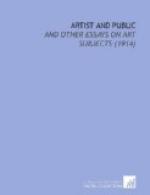This conservatism of American painting, however, is not of the kind that still marks so much of the painting of England. Excepting exceptions, English painting is somewhat stolidly staying where it was. America’s conservatism is ardent, determined, living. It is not standing still; it is going somewhere as rapidly as possible—it might, perhaps, be more truly called not conservatism but reaction. We have, of course, our ultramodernists, but their audacities are mild compared to those of the French or German models they imitate. We have, even more of course, the followers of the easiest way—the practitioners of current and accepted methods who are alike everywhere. But our most original and most distinguished painters, those who give the tone to our exhibitions and the national accent to our school, are almost all engaged in trying to get back one or another of the qualities that marked the great art of the past. They have gone back of the art of the day and are retying the knots that should bind together the art of all ages.
This tendency shows itself strongly even in those whose work seems, at first sight, most purely naturalistic or impressionistic. Among those of our painters who have adopted and retained the impressionist technic, with its hatching of broken colors, the two most notable are Mr. Hassam and Mr. Weir. But Mr. Hassam, at his best, is a designer with a sense of balance and of classic grace almost equal to that of Corot, and he often uses the impressionist method to express otherwise the delicate shimmer of thin foliage that Corot loved. Nay, so little is he a pure naturalist, he cannot resist letting the white sides of naked nymphs gleam among his tree trunks—he cannot refrain from the artist’s immemorial dream of Arcady. As for Mr. Weir, surely nothing could be more unlike the instantaneousness of true impressionism than his long-brooded-over, subtle-toned, infinitely sensitive art.
There is little dreaminess in the work of Mr. Tarbell and the growing number of his followers. Theirs is almost a pure naturalism, a “making it like.” Yet, notably in the work of Mr. Tarbell himself, and to some extent in that of the others, there is an elegance of arrangement, a thoroughness in the notation of gradations of light, a beauty and a charm that were learned of no modern. Their art is an effort to bring back the artistic quality of the most artistic naturalism ever practised, that of Vermeer of Delft.




